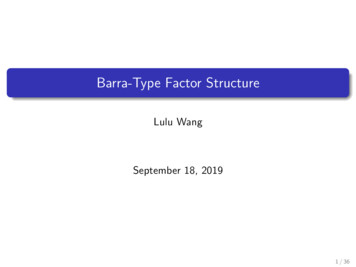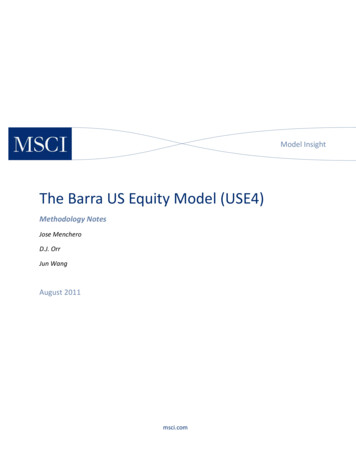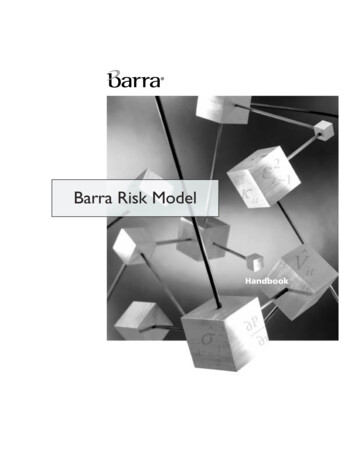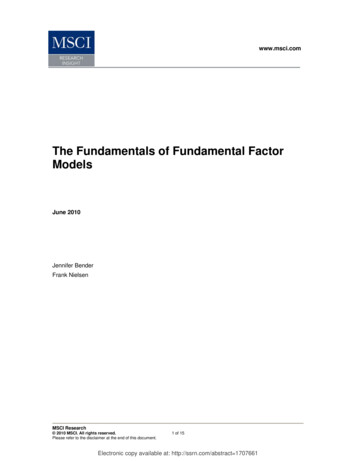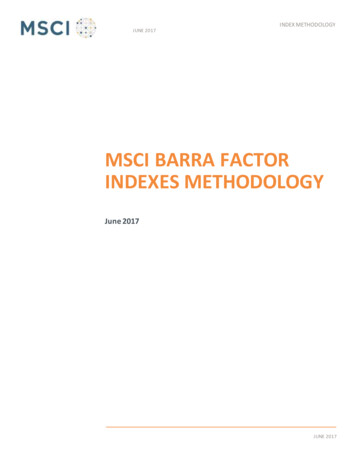
Transcription
INDEX METHODOLOGYJUNE 2017MSCI BARRA FACTORINDEXES METHODOLOGYJune 2017JUNE 2017
MSCI BARRA FACTOR INDEXES METHODOLOGY JUNE 2017CONTENTS1Introduction.32Main Characteristics of MSCI Long-Short Barra Factor Indexes .43Constructing the MSCI Long-Short Barra Factor Indexes .53.1 Specifying the Parent Index, Benchmark and the Barra Equity Model foroptimization .543.2Specifying the Target Factor and optimization objectives .63.3Specifying the optimization constraints .63.4Calculating the optimized index.7Maintaining the MSCI Barra Factor Indexes.84.1Monthly index reviews .84.2Ongoing event related changes .8Appendix I: Current List of MSCI Barra Factor Indexes as of June 2009. 10Appendix II: Optimization Settings for Constructing MSCI Long-ShortBarra Factor Indexes . 11Appendix III: Monthly Rebalancing Timeline. 14Appendix IV: Defining Shorting Cost Cutoff . 15Appendix V: Defining Trade Limits. 16Appendix VI: Handling Infeasible Optimizations . 17Appendix VII: New release of Barra Equity Model or Barra Optimizer. 18Appendix VIII: Barra Model Data Delays or Corrections. 19Appendix IX: Constructing the MSCI Long-Only Barra Factor Indexes. 20 2017 MSCI Inc. All rights reserved. Please refer to the disclaimer at the end of this document.MSCI.COM PAGE 2 OF 25
MSCI BARRA FACTOR INDEXES METHODOLOGY JUNE 20171INTRODUCTIONFundamental factors have become increasingly important in various areas of the investmentprocess, including risk management and portfolio construction. Fundamental factorsrepresent sources of systematic risk and return.MSCI has done extensive research to identify the common factors driving equity marketsand build factor models to capture these common sources of risk and return. MSCI researchshows that three types of fundamental factors account for a significant part of thecommonality in equity returns across different markets and time periods: country factors,industry factors, and style factors. The main style factors include size, value, momentum,volatility, and growth, to name just a few.MSCI has developed a family of Barra Factor Indexes that aim to capture some of theseimportant style factors in an index. The MSCI Long-Short Barra Factor Indexes areconstructed by optimizing a parent MSCI Index to achieve a specified high level of exposureto a particular style factor (herein, “Target Factor”), very low exposure to all other style,industry and country factors, and low tracking error to a corresponding MSCI benchmarkindex 1 (herein, “Benchmark”). For institutional investors with restrictions on shorting, MSCIalso calculates MSCI Long-Only Barra Factor Indexes constructed using a similar optimizationprocess but designed to maximize exposure to the Target Factor while controlling exposureto other factors and minimizing tracking error relative to the Benchmark. MSCI currentlyoffers Barra Factor Indexes that target the momentum, leverage, volatility, value andearnings yield factors and may expand the index family to cover a wider range of factors.This methodology book describes a generic methodology to create MSCI Barra FactorIndexes based on the existing MSCI global or domestic equity indexes (herein, “ParentIndexes”) using the Barra Optimizer and the relevant Barra Equity Model. Furtherinformation about the MSCI Barra Factor Indexes, Barra Optimizer and the various BarraEquity Models can be found at www.msci.com/research-archive.1Typically the corresponding MSCI Standard Index 2017 MSCI Inc. All rights reserved. Please refer to the disclaimer at the end of this document.MSCI.COM PAGE 3 OF 25
MSCI BARRA FACTOR INDEXES METHODOLOGY JUNE 20172MAIN CHARACTERISTICS OF MSCI LONG-SHORT BARRA FACTORINDEXESThe MSCI Long-Short Barra Factor Indexes aim to have the following characteristics: Performance similar to that of the Benchmark plus the Target Factor Specified high exposure2 to the Target Factor relative to the Benchmark Low exposure to other factors relative to the Benchmark Low tracking error relative to the Benchmark Controlled level of index turnover Monthly rebalancingA pure factor replicating index could be composed of all securities present in the estimationuniverse of the relevant Barra Equity Model (typically thousands of large, mid and smallcapitalization securities) with long and short positions. This index woul d incur high turnoverwith most security weights changing at each monthly update of the model. A methodologyto create reasonably replicable indexes needs to incorporate a number of constraints, suchas constraints on the number of index constituents, monthly index turnover, trade limit andshorting costs to achieve replicability and investability.2The target factor exposure may be positive or negative depending on the Target Factor. Please refer to Appendix I. 2017 MSCI Inc. All rights reserved. Please refer to the disclaimer at the end of this document.MSCI.COM PAGE 4 OF 25
MSCI BARRA FACTOR INDEXES METHODOLOGY JUNE 20173CONSTRUCTING THE MSCI LONG-SHORT BARRA FACTOR INDEXES 3The MSCI Long-Short Barra Factor Indexes are constructed by optimizing an MSCI ParentIndex to achieve a specified stable level of exposure to the Target Factor and a controlledlevel of exposure to all other style, industry and country factors, while minimizing thetracking error relative to the Benchmark, for a given set of constraints. Constructing theMSCI Barra Factor Indexes involves the following steps: Specifying the Parent Index, Benchmark and the Barra Equity Model for optimization Specifying the Target Factor and optimization objective Specifying the optimization constraints Calculating the optimized indexThe steps for constructing the MSCI Long-Short Barra Factor Indexes are described below.3.1SPECIFYING THE PARENT INDEX, BENCHMARK AND THE BARRA EQUITY MODELFOR OPTIMIZATIONConstructing the MSCI Barra Factor Indexes begins with selecting the Parent Index,Benchmark and the relevant Barra Equity Model for the optimization. For the MSCI LongShort Barra Factor Indexes: the Parent Index is the corresponding MSCI Investable Market Index and serves as theuniverse of eligible securities for the optimization; the Benchmark for the optimization is the corresponding MSCI Standard Index; and the Barra Equity Model is the corresponding global, regional or single country BarraEquity Model.For example, to construct the MSCI Europe Long-Short Barra Factor Indexes, the MSCIEurope Investable Market Index would be used as the universe of eligible securities, MSCIEurope Index would be used as the Benchmark for the optimization, and the Barra EuropeShort-Term Model would be used as the risk model for the optimization.The optimization relies on the factor exposures for all the securities in the Parent Index andthe factor co-variance matrix of the relevant Barra Equity Model. The optimization isperformed from a base currency perspective (e.g., Euro for the MSCI Europe Barra FactorIndexes) and allows short selling of securities.3Please refer to Appendix IX for the construction of MSCI Long-Only Factor Indexes. 2017 MSCI Inc. All rights reserved. Please refer to the disclaimer at the end of this document.MSCI.COM PAGE 5 OF 25
MSCI BARRA FACTOR INDEXES METHODOLOGY JUNE 20173.2SPECIFYING THE TARGET FACTOR AND OPTIMIZATION OBJECTIVESThe optimization objective of the MSCI Long-Short Barra Factor Index is to have the lowesttracking error relative to the Benchmark, subject to the optimization constraints specified inSection 3.3.Depending on the Target Factor, the MSCI Long-Short Barra Factor Index will target 1 or -1standard deviation of exposure relative to the Benchmark. Please refer to Appendix I for thecurrent list of MSCI Long-Short Barra Factor Indexes and their Target Factor Exposure.3.3SPECIFYING THE OPTIMIZATION CONSTRAINTSAt each monthly index rebalancing, a number of optimization constraints are employed in aneffort to control the level of active exposure to other factors, as well as to achieve a balancebetween the objectives of replicability and investability, high exposure to the Target Factor,low tracking error to the Benchmark, limited stock specific risk, and low index turnover. At each monthly index rebalancing, the Target Factor exposure of the MSCI Long-ShortBarra Factor Index will be fixed at a pre-defined level as specified in Appendix I (i.e., onestandard deviation above or below the Target Factor exposure of the Benchmark, inabsolute terms). At each monthly index rebalancing, the Barra style factor exposure of the MSCI LongShort Barra Factor Index will not deviate more than /- 0.1 standard deviations from theBarra style factor exposure of the Benchmark, in absolute terms, with the exception ofthe Target Factor. At each monthly index rebalancing, the Barra industry factor exposure of the MSCI LongShort Barra Factor Index will not deviate more than /- 0.5% from the Barra industryfactor exposure of the Benchmark, in absolute terms. At each monthly index rebalancing, the Barra country factor exposure of the MSCI LongShort Barra Factor Index will not deviate more than /- 0.5% from the Barra countryfactor exposure of the Benchmark, in absolute terms. At each monthly index rebalancing, the MSCI Long-Short Barra Factor Index will onlyinclude securities that are constituents of the Parent Index. At each monthly index rebalancing, the MSCI Long-Short Barra Factor Index will haveshort positions only in securities whose Shorting Cost is below the Shorting Cost Cutoffdefined in Appendix IV At each monthly index rebalancing, the leverage of the MSCI Long-Short Barra FactorIndex will be fixed at a pre-defined level as specified in Appendix I. 2017 MSCI Inc. All rights reserved. Please refer to the disclaimer at the end of this document.MSCI.COM PAGE 6 OF 25
MSCI BARRA FACTOR INDEXES METHODOLOGY JUNE 20173.4 At each monthly index rebalancing, the number of index constituents is constrained to amaximum of 400. At each monthly index rebalancing, the one-way index turnover of the MSCI Long-ShortBarra Factor Index is constrained to a maximum of 5% of the gross initial portfolio (Sumof absolute value of the long and short equity position). At each monthly index rebalancing, the weight of each index constituent will not changemore than a predefined Trade Limit4 linked to the stock’s Average Daily Traded Value. At each monthly index rebalancing, the weight of an index constituent will not deviatemore than /- 2% from its weight in the Benchmark. When this constraint is in conflictwith the Trade Limit constraint defined above, the Trade Limit constraint takesprecedence.CALCULATING THE OPTIMIZED INDEXThe MSCI Barra Factor Index is constructed using the Barra Optimizer in combination withthe relevant Barra Equity Model. The optimization uses the MSCI Parent Index as theuniverse of eligible securities and the specified optimization objective and constraints todetermine the optimal Barra Factor Index. Please refer to Appendix II for the optimizationsettings for constructing the MSCI Long-Short Barra Factor Indexes. In the event of aninfeasible optimization, the rules outlined in Appendix VI will be followed.4Please refer to Appendix V for the calculation of the Trade Limit. 2017 MSCI Inc. All rights reserved. Please refer to the disclaimer at the end of this document.MSCI.COM PAGE 7 OF 25
MSCI BARRA FACTOR INDEXES METHODOLOGY JUNE 20174MAINTAINING THE MSCI BARRA FACTOR INDEXES4.1MONTHLY INDEX REVIEWSThe index review of the MSCI Barra Factor Indexes is scheduled for the beginni ng of eachmonth following the release by Barra to its clients of the monthly updates of the securityexposure data and factor co-variance data of the relevant Barra Equity Model. Therebalancing date for the MSCI Barra Factor Indexes is as specified in Appendix III (the“Rebalancing Date”). The Rebalancing Date of the MSCI Barra Factor Indexes may varydepending on the release date of the monthly update of the corresponding Barra EquityModel. The release date of the monthly update of the relevant Barra Equity Model will beannounced to all Barra Factor Index clients on or before the release.The rebalancing of the MSCI Barra Factor Indexes is conducted as of the close of theRebalancing Date. The changes resulting from the index rebalancing will be announced onthe close of the Rebalancing Date and will be implemented as of the close of the secondbusiness day following the Rebalancing Date and will be effective from the third businessday following the Rebalancing Date.Please refer to Appendix III for further information about the monthly rebalancing timeline.4.2ONGOING EVENT RELATED CHANGESThe general treatment of corporate events in the MSCI Barra Factor Indexes aims tominimize turnover outside of Index Reviews. The methodology aims to appropriatelyrepresent an investor’s participation in an event based on relevant deal terms and pre-eventweighting of the index constituents that are involved. Further, changes in index marketcapitalization that occur as a result of corporate event implement
the Barra Equity Model is the corresponding global, regional or single country Barra Equity Model. For example, to construct the MSCI Europe Long-Short Barra Factor Indexes, the MSCI Europe Investable Market Index would be used as the universe of eligible securities, MSCI Europe Index would be used as the Benchmark for the optimization, and the Barra Europe Short-Term Model would be used as the risk
